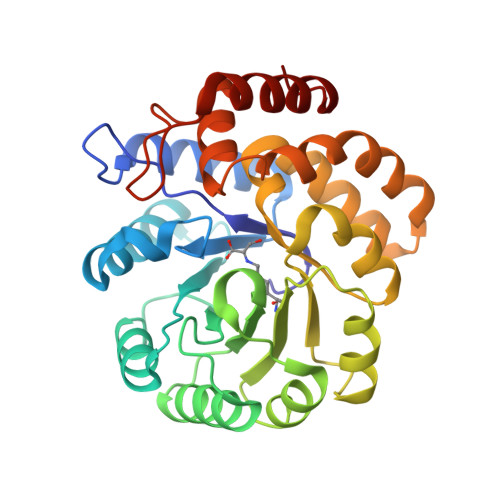Conserved main-chain peptide distortions: A proposed role for Ile203 in catalysis by dihydrodipicolinate synthase
Dobson, R.C.J., Griffin, M.D.W., Devenish, S.R.A., Pearce, F.G., Hutton, C.A., Gerrard, J.A., Jameson, G.B., Perugini, M.A.(2008) Protein Sci 17: 2080-2090
- PubMed: 18787203
- DOI: https://doi.org/10.1110/ps.037440.108
- Primary Citation of Related Structures:
3C0J - PubMed Abstract:
In recent years, dihydrodipicolinate synthase (DHDPS, E.C. 4.2.1.52) has received considerable attention from a mechanistic and structural viewpoint. DHDPS catalyzes the reaction of (S)-aspartate-beta-semialdehyde with pyruvate, which is bound via a Schiff base to a conserved active-site lysine (Lys161 in the enzyme from Escherichia coli). To probe the mechanism of DHDPS, we have studied the inhibition of E. coli DHDPS by the substrate analog, beta-hydroxypyruvate. The K (i) was determined to be 0.21 (+/-0.02) mM, similar to that of the allosteric inhibitor, (S)-lysine, and beta-hydroxypyruvate was observed to cause time-dependent inhibition. The inhibitory reaction with beta-hydroxypyruvate could be qualitatively followed by mass spectrometry, which showed initial noncovalent adduct formation, followed by the slow formation of the covalent adduct. It is unclear whether beta-hydroxypyruvate plays a role in regulating the biosynthesis of meso-diaminopimelate and (S)-lysine in E. coli, although we note that it is present in vivo. The crystal structure of DHDPS complexed with beta-hydroxypyruvate was solved. The active site clearly showed the presence of the inhibitor covalently bound to the Lys161. Interestingly, the hydroxyl group of beta-hydroxypyruvate was hydrogen-bonded to the main-chain carbonyl of Ile203. This provides insight into the possible catalytic role played by this peptide unit, which has a highly strained torsion angle (omega approximately 201 degrees ). A survey of the known DHDPS structures from other organisms shows this distortion to be a highly conserved feature of the DHDPS active site, and we propose that this peptide unit plays a critical role in catalysis.
- Department of Biochemistry and Molecular Biology, University of Melbourne, Parkville, Victoria 3010, Australia. rdobson@unimelb.edu.au
Organizational Affiliation:




















